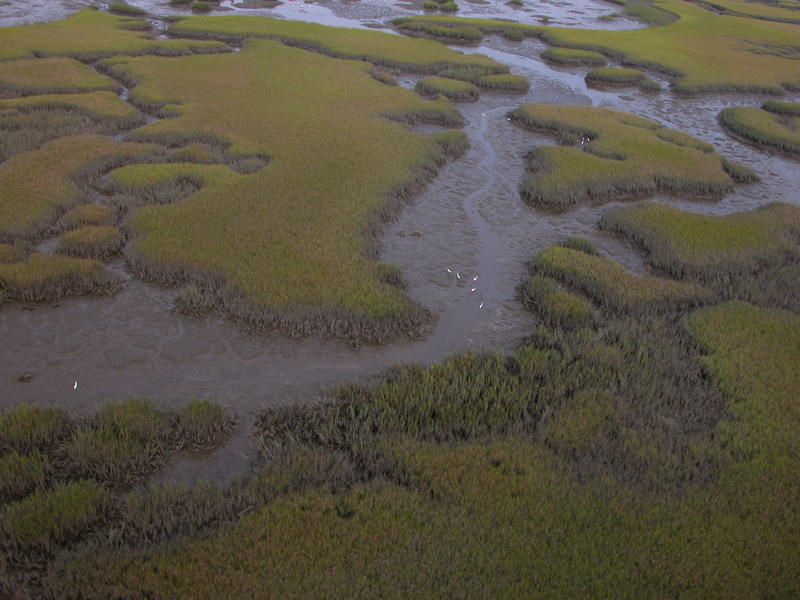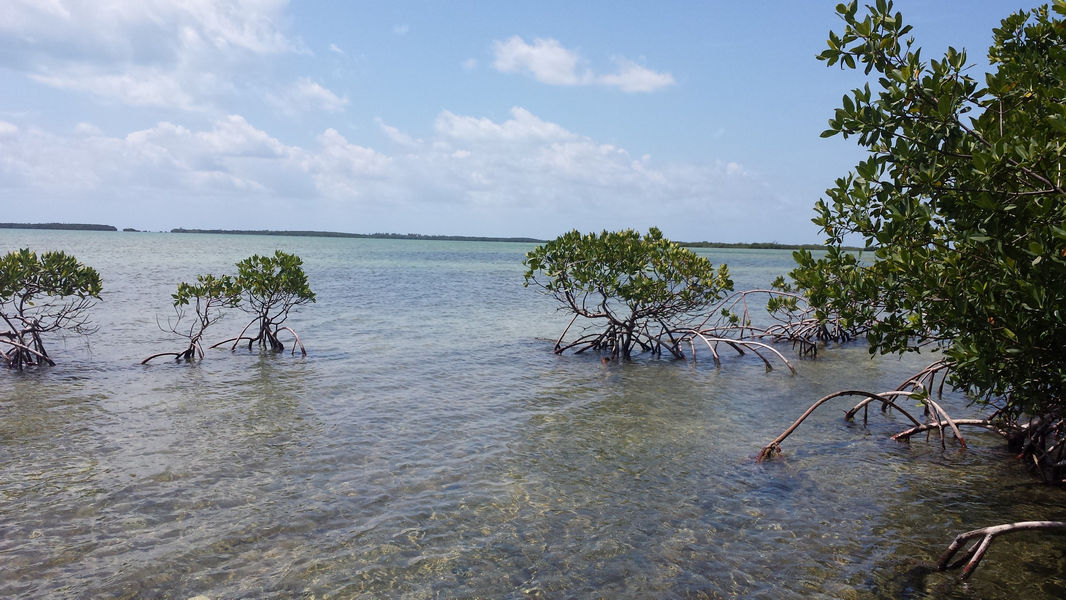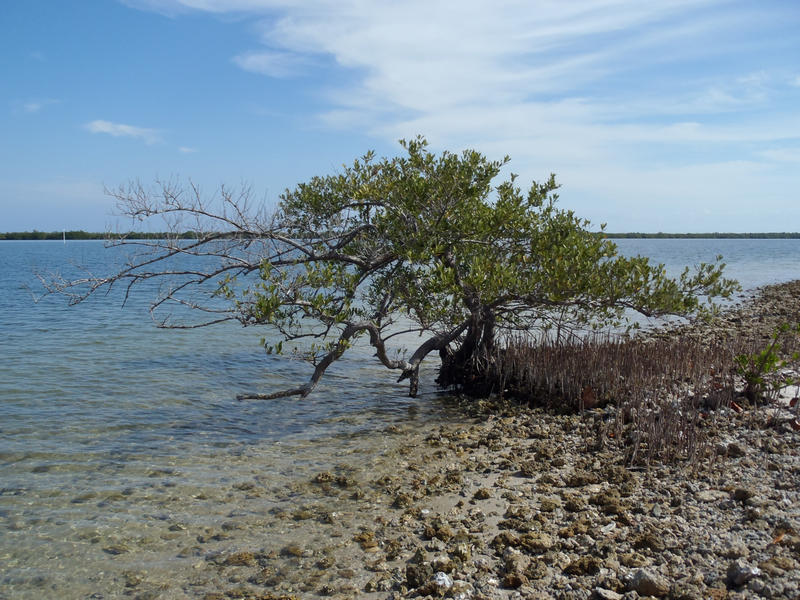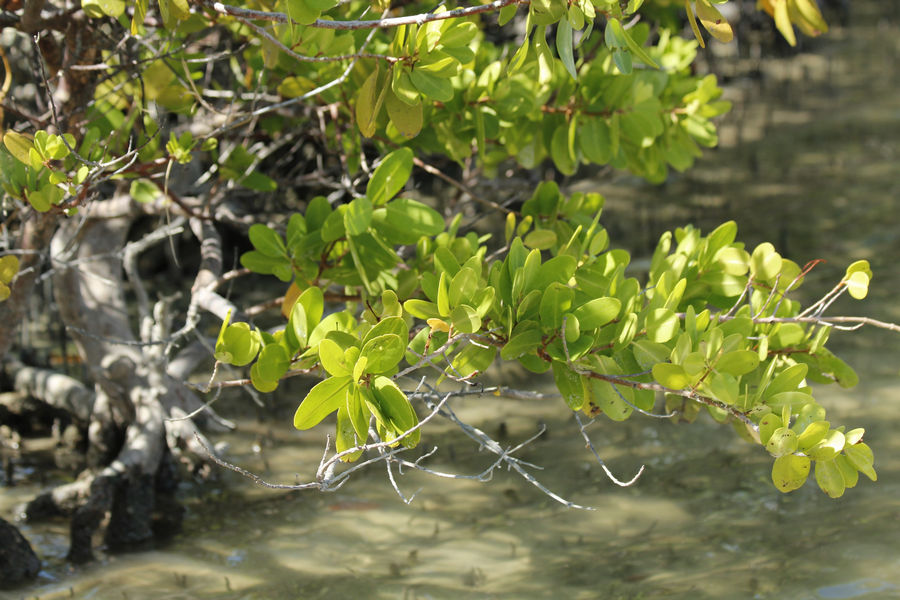Mangroves are one of Florida's true natives. They thrive in salty environments because they can obtain freshwater from saltwater. Some secrete excess salt through their leaves, while others block absorption of salt at their roots.
Florida's estimated 600,000 acres of mangrove forests contribute to the overall health of the state's southern coastal zone and beyond. This ecosystem traps and cycles various organic materials, chemical elements and important nutrients. Mangrove roots act not only as physical traps but provide attachment surfaces for various marine organisms. Many of these attached organisms filter water through their bodies and, in turn, trap and cycle nutrients.
The relationship between mangroves and their associated marine life cannot be overemphasized. Mangroves provide protected nursery areas for fishes, crustaceans and shellfish. They also provide food for a multitude of marine species such as snook, snapper, tarpon, jack, sheepshead, red drum, oyster and shrimp. Florida's important recreational and commercial fisheries would drastically decline without healthy mangrove forests.
Many animals find shelter either in the roots or branches of mangroves. Mangrove branches are rookeries, or nesting areas, for beautiful coastal birds such as brown pelicans and roseate spoonbills.
Worldwide, more than 50 species of mangroves exist. Of the three species found in Florida, the red mangrove (Rhizophora mangle) is probably the most well-known. It typically grows along the water's edge. The red mangrove is easily identified by its tangled, reddish roots called "prop-roots." These roots have earned mangroves the title of "walking trees." This mangrove, in particular, appears to be standing or walking on the surface of the water.
The black mangrove (Avicennia germinans) usually occupies slightly higher elevations upland from the red mangrove. The black mangrove can be identified by numerous finger-like projections, called pneumatophores, that protrude from the soil around the tree's trunk.
The white mangrove (Laguncularia racemosa) usually occupies the highest elevations farther upland than either the red or black mangroves. Unlike its red or black counterparts, the white mangrove has no visible aerial root systems. The easiest way to identify the white mangrove is by the leaves. They are elliptical, light yellow green and have two distinguishing glands at the base of the leaf blade where the stem starts.
All three of these species utilize a remarkable method of propagation. Seeds sprout while still on the trees and drop into the soft bottom around the base of the trees or are transported by currents and tides to other suitable locations.
Florida's mangroves are tropical species; therefore, they are sensitive to extreme temperature fluctuations as well as subfreezing temperatures. Research indicates that salinity, water temperature, tidal fluctuations and soil also affect the growth and distribution of mangroves. They are common as far north as Cedar Key on the Gulf Coast and St. Augustine on the Atlantic Coast. Black mangroves can occur farther north in Florida than the other two species. Frequently, all three species grow intermixed.
People living along the south Florida coasts benefit many ways from mangroves. Mangrove forests protect uplands from storm winds, waves and floods. The amount of protection afforded by mangroves depends upon the width of the forest. A very narrow fringe of mangroves offers limited protection, while a wide fringe can considerably reduce wave and flood damage to landward areas by enabling overflowing water to be absorbed into the expanse of forest. Mangroves can help prevent erosion by stabilizing shorelines with their specialized root systems. Mangroves also filter water and maintain water quality and clarity.
Changes In Florida's Mangrove Distribution
It is true that mangroves can be naturally damaged and destroyed, but there is no doubt that human impact has been most severe. Scientists in multiple agencies, including the Florida Wildlife Research Institute, Smithsonian Institute, Florida Department of Environmental Protection and many more are studying changes in Florida's coastal habitats. The scientists evaluate habitat changes by analyzing aerial photographs from the 1940s and 1950s and satellite imagery and aerial photography from the 1980s. Frequently the changes illustrate loss of mangrove acreage. Through researching the history of study sites, these losses are often attributed to human activities.
However, mangroves are also gaining ground along their northern Florida habitat limits. As winter cold snaps decrease, mangroves are able to expand further north into new territory. Continued evaluation of aerial images between 1984 and 2011 has shown that the Florida Atlantic Coast gained more than 3,000 acres of mangroves. All the increase occurred north of Palm Beach County and the acreage between Cape Canaveral and St. Augustine doubled. Much of these gains come at the expense of salt marsh communities. Research is ongoing to determine the impacts, both positive and negative, of this transition.
State and local regulations have been enacted to protect Florida's mangrove forests. Local laws vary. Be sure to check with officials in your area prior to taking any action to determine if a permit is required. Learn more about state regulations.
Mangroves are one of Florida's true natives and are part of our state heritage. It is up to us to ensure a place in Florida's future of one of our most valuable coastal resources - mangroves.





